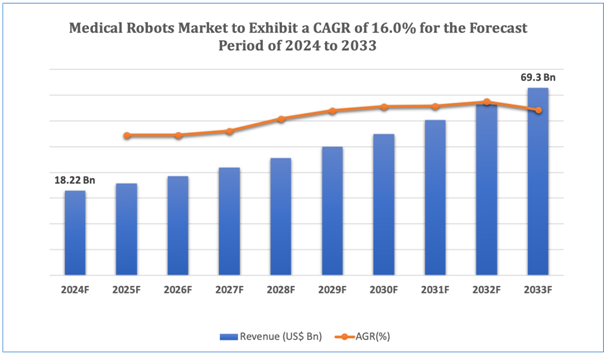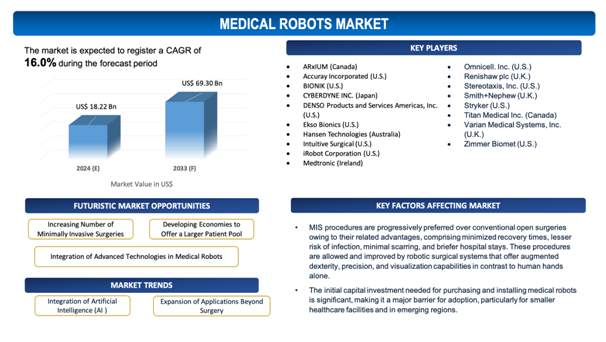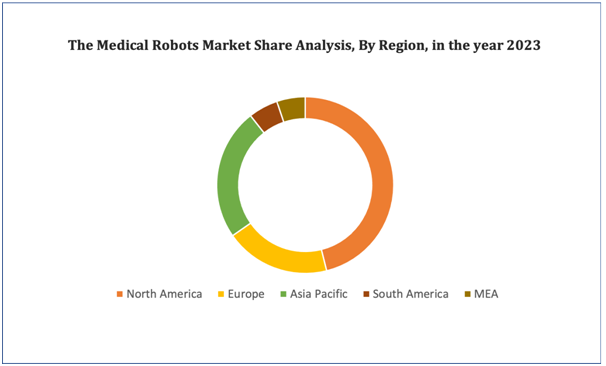Medical Robots Market Overview
The global medical robots market is estimated to be worth over USD 69.3Bn in 2033 and is expected to grow at CAGR of 16.0% during the forecast period (2024-2033).
Medical robots have emerged as a revolution in the healthcare landscape in recent times, offering transformative innovations and breakthroughs in diagnosis, surgery, and patient care. These robots surrounds a scale of technologies, from surgical assistants to diagnostic aids and rehabilitation devices, each intended to improveefficiency,precision, and outcomes in medical procedures.
In surgery, robots like the da Vinci Surgical System have allowed minimally invasive procedures with higher precision and minimized recovery times. Surgeons can perform complex maneuvers with improvedproficiency and visualization, resulting inlessercomplexities and shorter hospital stays for patients. In a similar manner, robotic exoskeletons have emerged as supports in rehabilitation, assisting patients recover from injuries or surgeries by offering targeted support and assistance in movement.
Diagnostic robots are also holding a critical role, especially in imaging and pathology. Automated systems can assess medical images with accuracy and speed beyond human capabilities, facilitating in early detection and treatment planning. In laboratories, robots are aligningmonotonous tasks such as sample handling and testing, enhancing efficiency and mitigating errors.
Beyond clinical settings, telepresence robots are connecting patients with healthcare providers remotely, particularly in underserved or remote areas. These robots allow consultations, monitoring, and even surgical assistance from a distance, expanding access to specialized care.
The incorporation of artificial intelligence (AI) further improves the capabilities of medical robots, enabling for real-time data analysis, predictive modelling, and personalized treatment plans. This alliance of robotics and AI commits even higher advancements in precision medicine and personalized healthcare.
Overall, medical robots are redefining healthcare by enhancing human capabilities, augmenting patient outcomes, and fuelling efficiencies across the healthcare continuum. As technology continues to evolve, the potential for medical robots to further revolutionize medicine and expand access to quality care remains promising.
Top of Form
Bottom of Form
Figure 1. Medical Robots: Market Size

Get more details on this report - Request Free Sample
Key Market Insights
The global medical robots market is experiencing swift growth and evolution, fuelled by developments in technology and growing adoption across diverse healthcare applications. As of latestevaluation, the market is growing with a compound annual growth rate (CAGR) anticipated to exceed 15% over the forthcoming years. This growth is accelerated by the increasing demand for minimally invasive surgeries, enhancements in healthcare infrastructure, and the soaring prevalence of chronic diseases.
Major developments in the market comprise the advent of next-generation robotic systems that provideimproved precision, efficiency, and safety in surgical procedures. Systems like the da Vinci Surgical System from Intuitive Surgical continue to dominate the surgical robotics segment, while newer entrants are focusing on specialized applications such as orthopaedics, neurosurgery, and cardiology.
In addition, robotic-assisted rehabilitation devices are gaining momentum for their capability to support recovery through targeted therapy and precise movement assistance. Companies are also advancing in diagnostic robotics, especially in automated imaging and pathology systems, leveraging AI and machine learning for faster and more precise diagnostics.
The market outlook is competitive, with leading players such as Intuitive Surgical, Stryker Corporation, and Zimmer Biomet Holdings leading in robotic surgical systems and rehabilitation devices. Collaborations between technology companies and healthcare providers are fostering innovation, while regulatory developments are ensuring the efficacy and safety of these technologies worldwide.
Looking ahead, the incorporation of artificial intelligence, 5G connectivity, and IoT capabilities are expected to further accelerate the market, allowing remote surgery, real-time data analytics, and personalized healthcare solutions.
Top of Form
Bottom of Form
Market Dynamics
Market Drivers
IncreasingNumber of Minimally Invasive Surgeries
The soaring number of minimally invasive surgeries (MIS) is a primary driver boosting the expansion of the global medical robots market. MIS procedures are progressively preferred over conventional open surgeries owing to their relatedadvantages, comprisingminimized recovery times, lesser risk of infection, minimal scarring, and briefer hospital stays. These procedures are allowed and improved by robotic surgical systems that offer augmenteddexterity, precision, and visualization capabilities in contrast to human hands alone.
Robotic surgical systems, such as the da Vinci Surgical System, have transformed MIS by offering surgeons with amplified, 3D views of the surgical site and instruments that imitate wrist-like movements with better range of motion. This enables surgeons to perform intricate procedures through small incisions with maximum accuracy, which is essential in delicate surgeries such as urological,cardiac, and gynaecological procedures.
The demand for medical robots is thereby directly associated with the growing adoption of MIS across diverse specialties. Hospitals and healthcare facilities are investing in robotic systems to fulfil patient demand for less invasive procedures while enhancing surgical outcomes. Also, the geriatric population globally, along with increasing incidences of chronic diseases that need surgical intervention, further fuels the market for robotic surgical systems that can perform complex procedures efficientlyand safely.
As technology continues to evolve, the integration of artificial intelligence and machine learning into robotic systems promises even more precise and personalized surgical capabilities, reinforcing the trend towards minimally invasive approaches in modern healthcare. As a result, the global medical robots market is anticipated to witnesssustained growth as healthcare providers seek to capitalize on these advancements to improve patient care and operational efficiency.
Top of Form
Bottom of Form
Market Restraints
With regard to numerous advantages of Medical Robots, the market faces several challenges due to the unique characteristics and requirements associated with these potent pharmaceutical products. Some of the key market challenges include:
- High Costs and Investment: The initial capital investment needed for purchasing and installing medical robots is significant, making it a major barrier for adoption, particularly for smaller healthcare facilities and in emerging regions. In addition, continuous costs related to maintenance, training, and upgrades further contribute to the financial strain on healthcare providers. The high costs deter market penetration and adoption rates, especially in regions with restrained healthcare budgets.
- Regulatory and Safety Concerns: Medical robots are subject to stringent regulatory requirements and safety standards to ensure patient safety and device efficiency. Obtaining regulatory approval for new robotic systems or upgrades can be a lengthy and costly process, delaying market entry and innovation. Alongside, concerns about potential technical failures, malfunctions, or errors in robotic-assisted procedures can create uncertainty among healthcare providers and patients, affecting adoption rates. Adherence to intricate regulatory frameworks across various global markets adds to the operational challenges faced by manufacturers in the medical robots sector.

Get more details on this report - Request Free Sample
Market Opportunity
Developing Economies to Offer a Larger Patient Pool
Developing economies stands as a notable market opportunity for the global medical robots market attributing to their proliferating healthcare infrastructure and expanding patient populations. As these regions continue to experience economic growth and urbanization, there is a equivalentrise in demand for innovative medical technologies to enhance healthcare delivery and outcomes.
One major advantage is the larger patient pool in developing economies, fuelled by factors such as aging demographics, population growth, and the increasing prevalence of chronic diseases. Medical robots can acknowledge these healthcare challenges by providing precise and minimally invasive surgical solutions that improve patient recovery times, minimize hospital stays, and enhance overall treatment outcomes. For instance, robotic surgical systems are especially beneficial in regions where skilled healthcare professionals are scarce, as they allow local practitioners to perform complex procedures with higherconsistencyand accuracy.
In addition to that, the adoption of medical robots in developing economies can aid in bridging the healthcare access gap between urban and rural areas. By deploying robotic systems in remote or underserved regions, healthcare providers can extend specialized medical services to more patients, thusenhancing healthcare equity and minimizing disparities.
Moreover, as these economies invest in upgrading their healthcare infrastructure and regulatory frameworks, there is soaring potential for manufacturers to introduce cost-effective robotic solutions customized to local needs and affordability constraints. This adaptability not only expands market reach but also promotes sustainable healthcare development in emerging markets.
To conclude, developing economies represent a promising frontier for the global medical robots market, offering opportunities for innovation, expansion, and addressing unmet medical needs. By leveraging these opportunities effectively, stakeholders can contribute to enhancing healthcare accessibility and quality on a worldwide scale.
Top of Form
Bottom of Form
Market Trends
- Integration of Artificial Intelligence (AI): There is a soaring trend towards incorporating artificial intelligence (AI) into medical robots to improve their capabilities. AI algorithms can assess large datasets, aid in real-time decision-making during surgeries, and enhance the precision of robotic movements. Machine learning algorithms are being used to refine robotic procedures, predict patient outcomes, and customize treatment plans based on individual patient data. This trend not only enhances the efficiency and precision of medical robots but also opens avenues for advanced applications such as autonomous surgery and adaptive robotic systems.
- Expansion of Applications Beyond Surgery: Medical robots are progressively being utilized beyond surgical applications. There is a trend towards developing robotic solutions for diagnostic imaging, rehabilitation, medication dispensation, and telemedicine. Robotic systems in diagnostic imaging can automate processes like MRI scanning and pathology analysis, leading to faster and more accurate diagnoses. In rehabilitation, robotic exoskeletons and assistive devices are helping patients regain mobility and strength after surgeriesand injuries. Telemedicine robots enable remote consultations and patient monitoring, improving access to healthcare in remote or underserved areas. This diversification of applications broadens the market potential for medical robots beyond conventional surgical settings, catering to a broader range of healthcare needs and improves overall patient care.
Medical Robots Market: Key Segments
By Type
- External Large Robots
- Geriatric Robot
- Assistive Robots
- Miniature in Vivo Robots
By Product
- Surgical Robots
- Rehabilitation Robots
- Hospital and Pharmacy Robots
- Bio Robotics
- Non-invasive Radio Surgery Robots
- Telepresence Robots
- Medical Transportation Robots
- Sanitation and Disinfectant Robots
By Modality
- Compact
- Portable
By Components
- Actuators
- Sensors
- Robot Controller
- Patient Cart
- Surgeon Console
- Vision Cart
- Dispensing System and Additional Products
By Application
- Neurology Applications
- Cardiology Applications
- Orthopaedic Applications
- Laparoscopic Applications
- Physical Rehabilitation
- Pharmacy Applications
By End User
- Hospitals
- Specialty Clinics
- Research Institutes
- Ambulatory Surgical Centres
- Laboratories
- Rehabilitation Centres
- Others
By Distribution Channel
- Direct Tender
- Retail Sales
- Third Party Distributors
- Others
By Key Geographical Regions
- North America
- Europe
- Asia-Pacific
- Middle East and Africa
- South America
Figure 4. Medical Robots Market: Distribution by Region

Get more details on this report - Request Free Sample
Medical Robots Market: Regional Analysis
North America leads the medical robots market owing to a strong foundation of healthcare facilities, increased investment from major players in developing innovative equipment, a higher rate of patient adoption of minimally invasive surgery, and an increase in research activities in this region.
Leading Medical Robots Developers
Industry Trends and Global Forecasts, 2023-2035 report features an extensive study of the current market landscape, market size and future opportunities associated with the Medical Robotsmarket, during the given forecast period. Further, the market report highlights the efforts of several stakeholders engaged in this rapidly emerging segment of the biopharmaceutical industry. Key takeaways of the Medical Robotsmarket are briefly discussed below.
The report includes the list of players operating in the global Medical Robots market. Some of the key players include:
- ARxIUM (Canada)
- Accuray Incorporated (U.S.)
- BIONIK (U.S.)
- CYBERDYNE INC. (Japan)
- DENSO Products and Services Americas, Inc. (U.S.)
- Ekso Bionics (U.S.)
- Hansen Technologies (Australia)
- Intuitive Surgical (U.S.)
- iRobot Corporation (U.S.)
- Medtronic (Ireland)
- Omnicell. Inc. (U.S.)
- Renishaw plc (U.K.)
- Stereotaxis, Inc. (U.S.)
- Smith+Nephew (U.K.)
- Stryker (U.S.)
- Titan Medical Inc. (Canada)
- Varian Medical Systems, Inc. (U.K.)
- Zimmer Biomet (U.S.)
Medical Robots Market: Key Developments
- In February 2024, The US Food and Drug Administration (FDA) has authorised the marketing of Virtual Incision’s MIRA Surgical System, a miniRAS device, for adult colectomy procedures.Featuring a compact size, the MIRA Surgical System weighs less than one kilogram, and its tray-to-table setup could make robotic surgery more accessible.
- In May 2024, Sony Group Corporation (Sony) announced the development of a microsurgery assistance robot capable of automatic surgical instrument exchange and precision control.
Scope of the Report
The market report presents an in-depth analysis of the various firms / organizations that are engaged in this market, across different segments, as defined in the below table:
|
|
Key Report Attributes |
Details |
||
|
|
Base Year |
2023 |
||
|
|
Forecast Period |
2024-2033 |
||
|
|
CAGR (2024-2033) |
16.0% |
||
|
|
Type |
|
||
|
|
Product |
|
||
|
|
Modality |
|
||
|
|
Components |
|
||
|
|
Application |
|
||
|
|
End User |
|
||
|
|
Distribution Channel |
|
||
|
|
Key Geographical Regions |
|
||
|
Key Companies Profiled |
|
|
||
